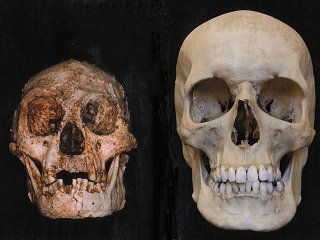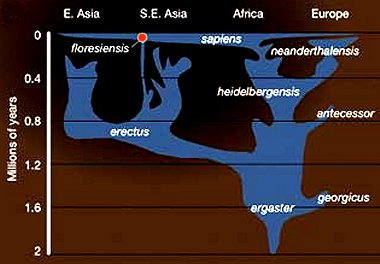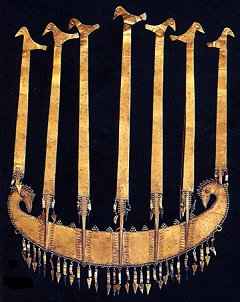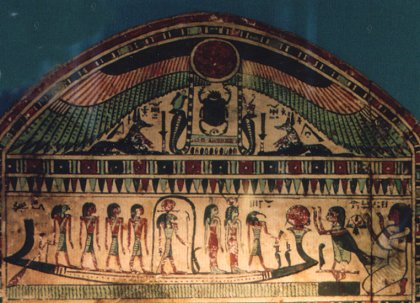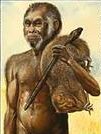"A Dutch palaeontologist, Dr Gert van den Bergh, a member of the team, was first shown the cave at a distance more than a decade ago, after hearing folk tales of the Ebu Gogo, which means 'grandmother who eats everything'.
"People living around the volcano told him a consistent story of the hairy creatures that devoured whatever they could grasp in their long fingers. The villagers tolerated the stealing of food until the Ebu Gogo began to snatch babies and eat them too. They then set upon the little people, forcing them out of the cave with bales of burning grass. Van den Bergh dismissed the tales as akin to those of leprechauns and elves, until the hobbit bones were found." (4)
Perhaps this whirlwind of controversy explains the erratic behaviour of certain Indonesian academics. Like the controversial Starchild Skull, the only way to establish the truth is to do the scientific tests, particularly on the DNA. There is some irony here. The Starchild Skull is readily available for such testing, but lacks funding, whereas homo floresiensis has the world's palaeontologists clamouring to examine the find, but may end up being shut away from the world...
A Case of Microcephaly?
The BBC's flagship science programme, Horizon, recently looked at the discovery of the 'Hobbit', and the controversy it has created in the world of academic palaeontology(5). Horizon has a tendency to side with the more conservative wing of science, effectively debunking theories that venture beyond the mainstream. But on this occasion, the team who had discovered homo floresiensis, and championed the find as an entirely new species of human, seemed to come out on top.
Various academics, clearly uncomfortable with the ramifications of the discovery, had looked into other possibilities to explain it away. Professor Jacob, in Indonesia, had sought out examples of pygmy humans among the communities in the immediate locality of the Liang Bua caves. Finding some relatively short folk, he declared the matter settled: the indigenous peoples of the area were naturally fairly little, and it only took a single case of microcephaly in a pygmy human to provide us with the homo floresiensis specimen of 18,000 years ago.

This idea was also favoured by several Western academics. Between them they set out to show that a precedent existed among the historical human population for a 3 foot high person with a minute brain capacity. Again, such a person would have had an extreme microcephalic pathology.
Surprisingly, perhaps, they managed to show that microcephalic human brains did not show the kinds of distorted forms normally associated with advanced pathology. This then implied that the seemingly normal shape of the homo floresiensis brain (recreated by modelling the inside skull case) could not actually rule out microcephalic pathology in that specimen.
These arguments seemed to cast a dark shadow over the exuberant claims of the field team. The sceptics claimed that 'critical faculties had been suspended' during the media furore over the discovery. This find was, they argued, nothing more than a microcephalic pygmy human, and the discovering team had made a terrible, and professionally embarrassing, mistake.
The field team were in trouble, particularly after the rather ignoble argument with Professor Jacob over possession of the remains of homo floresiensis. They needed to find a second specimen to disprove the sceptics. And, it turned out, they had just a specimen in the form of a second lower mandible. This relic had the same abnormal structure as the first, indicating that homo floresiensis was not an isolated case. The microcephalic pygmy argument could not hold water in the face of two such specimens found in such close proximity. The odds of such an event occurring would be astronomical.
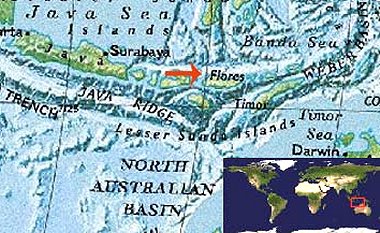
Homo floresiensis clearly does not fit into the evolutionary structure established by palaeontology. If this new species evolved from groups of homo erectus isolated in Indonesia, then they must have worked out ways of travelling between islands (principally from Java to Flores). The technological skills exhibited by their stone tools alone are also not in keeping with their brain sizes, at least according to anthropological theory. But such is life! Science has always had to adapt to new evidence, and bizarre facts which challenge pre-existing assumptions held dear by academics.
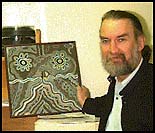
My gut feeling is that this discovery will pass into the history books of science as another remarkable landmark which was initially challenged tooth and nail by the establishment. This opinion has been bolstered by an interview on Radio 4's 'Today' programme with Professor Mike Morwood, one of the leading members of the team of anthropologists in Flores (7). (This picture of Mike Morwood shows him with a (presumably) aboriginal picture which strangely seems to show two suns over a mountain... Just like the Mesopotamian Niram-Sin Stele (below)).
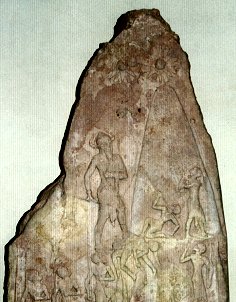
Interviewed by James Naughtie (allegedly pronounced 'Nocherty'), Professor Morwood cited the discovery of more jawbones of Homo Floresiensis as evidence that this is a new species of human (8). The various remains of Homo Floresiensis display "an array of distinctive characteristics" which set the species apart from Homo Sapiens Sapiens. He suggested that this remarkable new species of dwarf humans evolved and adapted in isolation on the island of Flores over the course of a million years. The archeological evidence indicates that the entire species became extinct following a massive volcanic eruption some 12,000 years ago which also wiped out the island's population of dwarf elephants.
The team, keen to discover more specimens of this new human species, have travelled back to the island of Flores to plan more digs. However, they are not allowed back into the Liang Bua limestone caves which are now closed to further investigation. This means that their work starts from scratch at a new site, and may take a decade to yield new results. It seems as though controversy and science are not happy bedfellows.
Modern-day Humans Found Walking on all Fours
Scientists have revealed information about a family of five siblings living in Turkey who walk on all fours. The Kurdish family suffer with some sort of rare genetic disorder and/or neurological condition that prevent them from carrying out sustained bipedal mobility. Some researchers have speculated that the genetic mutation involved is akin to 'reverse evolution', but this claim is disputed by others in the field (10). Nevertheless, the case has generated much professional debate.
Of interest to our discussion here is the fact that this kind of condition has been associated with microcephaly:
"Based on brain scans, the scientists ascribed the condition to a type of disorder called an ataxia, tied to underdevelopment of the cerebellum, a brain structure. Yet this can’t be the whole explanation, they added; it could be “a combination of unusual factors—genetic, physiological, psychological and social.” The German team noted that affected people also have abnormally small heads, a condition called microcephaly, which Charles Darwin cited as a possible evolutionary “regression” in his On the Origin of Species." (10)
People affected by ataxia are generally still bi-pedal, but wobbly in their gait and balance. The family in Turkey have a good sense of balance developed, however, but have retained this sense of balance by walking well on all fours. The pathological condition called "Disequilibrium Syndrome' appears to be a major contributing factor in this case, but what has stunned researchers is the exact way the siblings walk. Instead of using their knuckles, as the quadrupedal great apes do, they have their hands palm-down, distributing their forward weight through their wrists (11). This is very unusual, even for normal human infants developing their mobility. Even when children do go through a phase of 'bear crawling', they normally make the transition to bipedal walking within months.
Potentially, this was how our ancestors mobilised. The British researchers wonder whether anthropologists have been right to model the gait of our austalopithicine ancestors on that of the chimpanzee, when an alternative is now available for study in our own midst. The idea that we went through a stage of 'wrist-walking' during our evolution is not entirely new, having been proposed by Russel Tuttle (12). Perhaps there is some merit in the case, bringing about another re-think regarding established views about the course of human evolution.
A wonderful documentary about this anthropological case has been shown publicly, highlighting both the complex human and cultural issues faced by the family as well as the serious questions confronted by the scientific community (13).
There seem to be a number of factors contributing to the quadrupedal gait of the 5 affected members of the Kurdish Turkish family. There is an underlying brain-damage, relate to a genetic defect. The cerebellum, the part of the brain controlling balance, is damaged. This, on its own, does not mean that a person is unable to walk, but it would certainly affect their balance and gait. Another structural aspect of the affected children's biology is their bone structure, which is certainly strange, and interested the palaeontologists interviewed on the programme. The German team analysing DNA samples from the family have found a mutation in a patch of DNA which may indicate a genetic problem. Finally, the austerity and cultural isolation faced by the family over several decades has undoubtedly contributed. The children didn't get the support they needed to develop and overcome these disabilities.
The question of DNA mutation is important to those following arguments proposed by Zecharia Sitchin, which is the main thrust of this website. If the problem is genetic in character, then the implication is that a single patch of genes altered relatively suddenly during the course of human evolution. The shift from quadrupedal mobility to bipedal walking implied by such a find would have to have been very rapid during the evolutionary development of humans. This would be a fascinating discovery, and would be supportive of Sitchin's claims that the predecessors of humans were altered genetically, culminating in a new species which emerged relatively quickly on Earth; our ancestors. Hopefully the German team in Berlin working on this case will have definitive results to share with the world in the near future.
That thought aside, what was wonderful to see was how the family responded to support and physiotherapy input. The children made great strides, literally! Within months they were able to use parallel bars and even take some normal steps. This is the best possible outcome, because their status as outcasts within their remote Kurdish community would change for the better, just as the controversy of their remarkable and bizarre ambulation becomes a world-wide talking point.
The Hobbit in Myth
The debate about whether Homo Floresiensis is a new human species, rather than a group of microcephalic humans, appears to be drawing to a close: the ancient 'hobbits' from the Indonesian island Flores are indeed part of a new species of human.
""We have answered the people who contend that the 'Hobbit' is a microcephalic," said world-renowned palaeoneurologist Dean Falk, who is also chairwoman of FSU's anthropology department. Her team's study of the skull, which included modelling both normal and microcephalic human brains, was published in the U.S. journal Proceedings of the National Academy of Sciences.
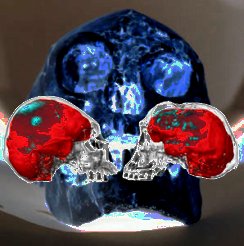
"The computer model reproduced the surface of the brain, including its shape, grooves and vessels, revealing what Falk described as a "highly evolved brain". Archaeologists had found sophisticated tools and evidence of a fire near the remains of the metre-tall adult female, who had a brain roughly one-third the size of a human from the same period. "People refused to believe that someone with that small a brain could make the tools. How could it be a sophisticated new species?" Falk said." (14)
So now that's settled, we can look at the repercussions of this amazing discovery. The location of the discovery is remote, and the tiny Hobbits of Flores were wiped out many thousands of years ago. However, there is no escaping the fact that these 'little people' really did exist. Which is interesting from the point of view of myth. There are a great many accounts of 'little people' appearing all around the world. Sometimes called fairies, or the Gentry, or the Sith, a whole folk mythology is built up around the supposed existence of a different species of intelligent beings co-habiting our world.
The renowned Ufologist Jacques Vallee has drawn our attention to the common ground shared by the fairy myths and more modern-day accounts of UFOs and alien abductions (15). He highlights ancient accounts of warrior pygmies, who were skilful archers, and asks this question:
"Were there or were there not races of dwarfs living among the West and Middle Europeans of antiquity? Were the legends about the fairies and the elves based on the fact that the ancient inhabitants of the northern parts of the British Isles were such a race?" (15)
Questions like this suddenly take on greater poignancy in the light of the discovery of Homo Floresiensis. After all, folk memories of human beings go back far further in time than our written records. In the same way that one might well argue that our global Flood mythologies have some basis in truth in a post-thaw period after the last Ice Age, then so too might the very real existence of the Hobbits from Indonesia have a connection with fairy mythology.
Microcephaly Refuted
Further scientific work carried out on the Homo floresiensis skulls and other skeletal remains have provided more evidence that the hobbit is not human. Instead, the hobbit descended from one of the archaic Homo ancestors along a different evolutionary line to ourselves.
"The results of the analysis of the asymmetry of the skulls, which refers to differences between the right and left sides of the skull, refutes the suggestion that the LB1 skull was that of a modern human with a diagnosis of microcephaly. In modern humans, a high degree of asymmetry may indicate that the individual was diseased. At least one scientific study on the asymmetry of LB1 supported the argument that this individual had microcephaly. Conversely, Dr. Baab and colleagues found the degree of asymmetry of the LB1 skull was not unexpectedly high and therefore not supportive of the diagnosis of microcephaly.
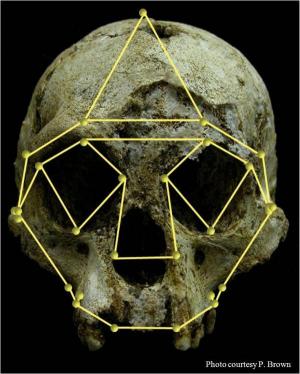
"Dr. Baab recognizes that the controversy as to the evolutionary origins of
Homo floresiensis will continue, perhaps without an answer. However, all the
evidence that she and colleagues illustrate in their article “Size, shape,
and asymmetry in fossil hominins: The status of the LB1cranium based on 3D
morphometric analyses,” suggest that Homo floresiensis was most likely the
diminutive descendant of a species of archaic Homo. The results of this study are also in line with what other researchers in
the Department of Anatomical Sciences at Stony Brook University have found
regarding the rest of the hobbit skeleton. Drs. William Jungers and Susan
Larson have documented a range of primitive features in both the upper and
lower limbs of Homo floresiensis, highlighting the many ways that these
hominins were unlike modern humans."
(16)
If one accepts the alternative view of humanity's emergence through some kind of external genetic meddling by visitors to our world, it might be interesting to speculate whether Homo floresiensis is how we would have turned out if evolution had been left to its own devices.
In other words, the hobbit is the organic descendent of the Homo line, and we are the genetically modified version.
Written by Andy Lloyd, 2004-2009
author of 'The Dark Star' (2005), 'Ezekiel One' (2009), 'The Followers of Horus' (2010), 'Darker Stars' (2019)
